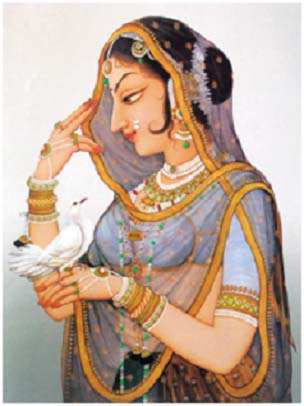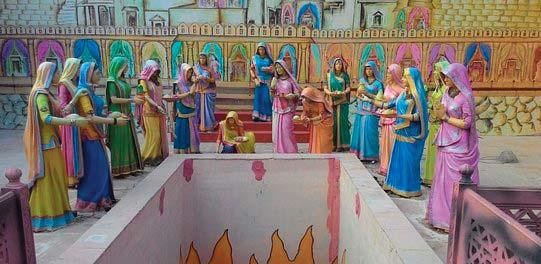False Pride

Can celebrating Jauhar (a mass Rajput ritual of self-immolation where in several women and children kill themselves to save their virtue from conquerors when defeat in an invasion seem imminent) in 21st century as pride, honor and bravery of women be justified as Hindu culture? As a woman, and as a mother of two, I would definitely say no, definitely not in this 21st century nor in any bygone era.
When director Sanjay Leela Bhansali (of Dil De Chuke Sanam, Devdas, RamLeela, Bhajirao Mastani fame) got slapped, pushed around and his set in Rajasthan ransacked while shooting a scene for his latest venture Padmavati, hell broke lose in both Hindi film industry and outside of it. This assault, led by a local Hindutva group, was based on the assumption that Bhansali was shooting a romantic dream sequence between the characters of Padmavati and the Sultan of Delhi, Alauddin Khalji. The problem to them was that as Padmavati was a “noble and honorable” Rajput queen (she is actually from Sri Lanka, in the poem) who preferred to commit Jauhar than succumbing to Khalji, it would be dishonoring her sacrifice and courage if such a romantic song, even as a dream, is shot between them. In addition, any romance between them would be, according to the protesting Hindutva group, a “distortion” of history.
There are, however, two indisputable facts contradicting the above disputable misguided narrative:

Rani Padmavati was a Sri Lankan Princess as depicted
in the fictional poem by Malik Muhammad Jayasi
One, Rani Padmavati is a fictional character, a heroine in a poem written in 1540 (See boxed item for her storyon pg 67), a solid 237 years after Alauddin Khalji’s Chittor campaign of 1303. This fiction is a tale of the celebration of a Rajput queen’s willingness to die rather than give herself over to a “tyrant (sic),” who coveted her. The fiction, titled Padmavat, was told in a long Awadhilanguage poem by the 16th century Sufi poet Malik Muhammad Jayasi. It has as its central characters Padmini or Padmavati the queen of Chittor, her husband, Rana Ratansen Singh, and the sultan of Delhi, Alauddin Khalji (also transcribed as Khilji). While all other characters are imaginary why the poet chose to include Khalji’s name in his poem remains a mystery.
There are no contemporary accounts of Alauddin’s siege that mention Padmavati. While there are still some historians who believe the story of The Padmavat to be true, almost everyone agree that Alauddin’s march on Chittor was more an expression of an ambitious ruler’s campaign of relentless military expansion rather than a lovesick man’s quest for a beautiful woman.
Two, even if assuming Rani Padmavati is historical and the story really took place, what is wrong if a director sees it through a different prism and reinvents a scenario? Shakespearean stories,
Christ’s life and even the Ramayana were interpreted in several ways by many authors so far. An artist eye travels to places where even the Sun cannot, they say. The thrill of any such creative conflict otherwise would be missing and movies and stories would become religious ceremonies.

Horror stories of Sati where women were drugged, tied and poked and forced down on the pyre with sticks to keep them burning live are well documented facts
However, what bothers me more is neither of the above-misplaced narratives but a more perilous and preeminent third one that has the potential to set a dangerous precedent for us women now, in 21st century. In this age and generation to where women have travelled through decades fighting inequality, sexism, abuse and rape, to view Jauhar and/or Sati, where women are forced in the name of culture and tradition to commit suicide (horror stories of Sati where women were drugged, tied and poked and forced down on the pyre with sticks to keep them from running away from a raging fire of Sati are well documented facts) are lauded as “bravery,” “honor” “pride (sic),” not only of the women killed but of an entire community and now to overall Hinduism, is alarming. It is shameful to say the least and undermines the hardships and work done by feminists and women’s rights’ activists. Centuries of turbulent, tear-filled brave fights against prejudice and abuse is being brought down in a jiffy in the name of ‘honor.’ Such outrages over woman’s “honor” is unnerving because it equates “honor and bravery” with a “pure” body. Rape and sexual assault yet again become a victim’s problem and ‘loss of “honor,”and hence death’ equation is peddled as a better choice than living with this bodily “stigma.”
Symbolic interpretations are important to any community’s social structure. But by making Sati and Jauhar symbols of woman’s bravery, strength, pride you are again pushing her into the world of darkness and sorrow where a woman’s body is given more importance than her spirit thus making her a commodity yet again. And Hindu woman raped by a Muslim? Out of question! Shame is doubled instantly and death is advocated as the best option. Remember the same Rajput community would commit atrocities over their women and people; give away their daughters in marriage to powerful kings in exchange of their own survival! Not that there is anything wrong with intra-community marriages. But it is the double standard that is utterly shameful.
When the rich and powerful embrace such twisted and false cultural prejudices equating them with pride of a community, it is trickled down to the masses and embraced by all and sundry and eventually becomes a ritual.
It’s a historical fact that Rajputs (who according to the census constitute only about three percent of Indian population) lacked war skills and were easily defeated by the more innovative, stunning military and war strategies of the Muslim invaders. While only upper castes could become captains of the Hindu army, Muslim kings would encourage strength and skill to rise in the hierarchy irrespective of their caste or religion. Hence many skillful commoners including Hindus could rise to the top of the rung in Muslim army whereas it was impossible amongst Hindu armies. In addition, Rajputs were lazy and spoiled. They had several in-fights and many plotted against one another to defeat their own clan members. That they gave away many of their daughters in marriage or in exchange for other favors to stronger rulers including Muslim kings is a well chronicled fact and has been a consistent point of shame to the Rajputs. To counter attack these ignoble deeds it is believed that Rajputs and their poets had many gallant poems written in the name of their valor, turning absolute defeats into pride-filled chivalrous deaths. The Rajputs dramatized almost all losses including that of Prithiviraj Chauhan to make them look like treacherous and deceitful murders by the invaders. They say that best poems come not from the winners but from the losers in war. One such fantasized story is that of Rani Padmavat of Chittor, a poem written by a Muslim poet Jayasi (who was then serving a Hindu king) just as Shakespeare wrote Hamlet. Both of them though wellknown fictions loved by all but can’t be misinterpreted as history.
History needs to be viewed through the prisms of time and date and move on from there. It’s not about Hindus against Muslims those days. It is just about winners and losers and everyone wanted to conquer as much land as possible, all of them, whether Muslim or Hindu. Sati and Jauhar are cruel practices invented by upper caste Hindus in the name of false prestige and pride at the cost of women and children who absolutely had no say in the matter. When have forced suicides become prideful acts? If women were left to fend for themselves they would have probably learned to fight their wars and shed those unnecessary acts of “pride” and “bravery” involving self-immolation and chastity. They would have probably chosen to become brave Rani Laxmi Bais than submissive Satis!

Depiction of Jauhar
Treating these notorious rituals as those of pride and honor will be doing injustice to the current crop of strong, capable, and educated women who came a long way to be where they are, doing what they are doing. They are still carrying the torch, running for their right, a right to live life their way, strongly, individually, taking one slow torturous step at a time. Hence, now to bring out an evil practice of days gone by such as Jauhar and Sati and call them acts of bravery, pride and honor, will dangerously push the clock back in time where women were just commodities bargained for power. In addition, it will undermine the hard work done to change the same. Women are already fighting modern day murder in the name of dishonor where Jauhar kund (a special well-like chamber for women and children to commit mass immolation) has moved from Rajput palaces to radiologists’ ultrasound chambers where the sex of the fetus is revealed and later relieved if it’s a female. Bringing back the glory (sic) of Jauhar and Sati Hindu. Sati and Jauhar are cruel practices invented by upper caste Hindus in the name of false prestige and pride at the cost of women and children who absolutely had no say in the matter. When have forced suicides become prideful acts? If women were left to fend for themselves they would have probably learned to fight their wars and shed those unnecessary acts of “pride” and “bravery” involving self-immolation and chastity. They would have probably chosen to become brave Rani Laxmi Bais than submissive Satis! Treating these notorious rituals as those of pride and honor will be doing injustice to the current crop of strong, capable, and educated women who came a long way to be where they are, doing what they are doing. They are still carrying the torch, running for their right, a right to live life their way, strongly, individually, taking one slow torturous step at a time. Hence, now to bring out an evil practice of days gone by such as Jauhar and Sati and call them acts of bravery, pride and honor, will dangerously push the clock back in time where women were just commodities bargained for power. In addition, it will undermine the hard work done to change the same. Women are already fighting modern day murder in the name of dishonor where Jauhar kund (a special well-like chamber for women and children to commit mass immolation) has moved from Rajput palaces to radiologists’ ultrasound chambers where the sex of the fetus is revealed and later relieved if it’s a female. Bringing back the glory (sic) of Jauhar and Sati would be death knell (pun unintended) to Indian women’s fight for freedom. Do we really want this regressive time-travel in the name of misplaced honor, pride and bravery? Hell no!

 1.408.254.0954
1.408.254.0954




